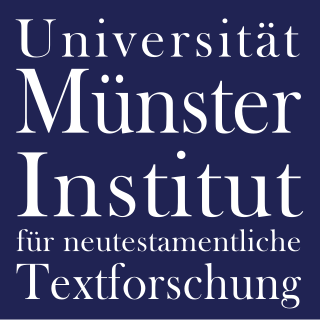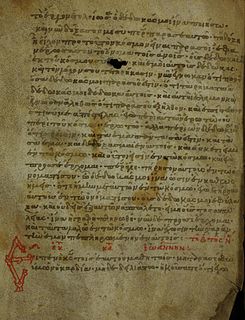Description
The codex contains lessons from the Gospels of John, Matthew, Luke lectionary (Evangelistarium), [4] on 319 parchment leaves (27 cm by 21.5 cm), with only one lacuna (the first leaf with John 1:1-17 and nine leaves at the end). [3] Nine leaves at the end were supplemented by a later hand. [3]

Gospel originally meant the Christian message itself, but in the 2nd century it came to be used for the books in which the message was set out. The four canonical gospels — Matthew, Mark, Luke and John — were probably written between AD 66 and 110, building on older sources and traditions, and each gospel has its own distinctive understanding of Jesus and his divine role. All four are anonymous, and it is almost certain that none were written by an eyewitness. They are the main source of information on the life of Jesus as searched for in the quest for the historical Jesus. Modern scholars are cautious of relying on them unquestioningly, but critical study attempts to distinguish the original ideas of Jesus from those of the later authors. Many non-canonical gospels were also written, all later than the four, and all, like them, advocating the particular theological views of their authors.

The Gospel of John is the fourth of the canonical gospels. The work is anonymous, although it identifies an unnamed "disciple whom Jesus loved" as the source of its traditions. It is closely related in style and content to the three Johannine epistles, and most scholars treat the four books, along with the Book of Revelation, as a single corpus of Johannine literature, albeit not from the same author.

The Gospel According to Matthew is the first book of the New Testament and one of the three synoptic gospels. It tells how the promised Messiah, Jesus, rejected by Israel, finally sends the disciples to preach the gospel to the whole world. Most scholars believe it was composed between AD 80 and 90, with a range of possibility between AD 70 to 110. The anonymous author was probably a male Jew, standing on the margin between traditional and non-traditional Jewish values, and familiar with technical legal aspects of scripture being debated in his time. Writing in a polished Semitic "synagogue Greek", he drew on three main sources: the Gospel of Mark, the hypothetical collection of sayings known as the Q source, and material unique to his own community, called the M source or "Special Matthew".
The text is written in Greek minuscule letters, in two columns per page, 22 lines per page. [1] [2] The headings in gold. According to Scrivener it is "a fine copy". [3] It contains musical notes. [4]
There are weekday Gospel lessons. [1]
History
Scrivener dated the manuscript to the 11th or 12th century, Gregory dated it to the 12th century. [3] [4] It has been assigned by the Institute for New Testament Textual Research to the 11th century. [1] [2]

The Institute for New Testament Textual Research at the University of Münster, Westphalia, Germany, is to research the textual history of the New Testament and to reconstruct its Greek initial text on the basis of the entire manuscript tradition, the early translations and patristic citations; furthermore the preparation of an Editio Critica Maior based on the entire tradition of the New Testament in Greek manuscripts, early versions and New Testament quotations in ancient Christian literature. Under Kurt Aland's supervision, the INTF collected almost the entire material that was needed - Manuscript count 1950: 4250; 1983: 5460; 2017: approx. 5800.
Of the history of the codex nothing is known until the year 1864, when it was in the possession of a dealer at Janina in Epeiros. It was then purchased from him by a representative of Baroness Burdett-Coutts (1814–1906), a philanthropist, [5] along with other Greek manuscripts. [4] They were transported to England in 1870-1871. [6] The manuscript was presented by Burdett-Coutts to Sir Roger Cholmely's School, and was housed at the Highgate (Burdett-Coutts II. 5), in London. [4]

Ioannina, often called Yannena within Greece, is the capital and largest city of the Ioannina regional unit and of Epirus, an administrative region in north-western Greece. Its population is 112,486, according to 2011 census. It lies at an elevation of approximately 500 metres above sea level, on the western shore of lake Pamvotis (Παμβώτις). Ioannina is located 410 km (255 mi) northwest of Athens, 260 kilometres southwest of Thessaloniki and 80 km east of the port of Igoumenitsa in the Ionian Sea.

Angela Georgina Burdett-Coutts, 1st Baroness Burdett-Coutts, born Angela Georgina Burdett, was a nineteenth-century philanthropist, the daughter of Sir Francis Burdett, 5th Baronet and Sophia, formerly Coutts, daughter of banker Thomas Coutts. In 1837 she became one of the wealthiest women in England when she inherited her grandfather's fortune of around £1.8 million following the death of her stepgrandmother, Harriot Mellon. She joined the surnames of her father and grandfather, by royal licence, to become Burdett-Coutts. Edward VII is reported to have described her as, "[a]fter my mother, the most remarkable woman in the kingdom."
The manuscript was added to the list of New Testament manuscripts by Scrivener (number 243) and Gregory (number 218). Gregory saw it in 1883. [4]
The manuscript is sporadically cited in the critical editions of the Greek New Testament (UBS3). [7]
The owner of the codex is unknown. The last place of its housing was Sotheby's. [1] [2]

Minuscule 535, 548 (Scrivener), ε 140, is a Greek minuscule manuscript of the New Testament, on a parchment, dated to the 12th century. It was adapted for liturgical use, with full marginalia.
Minuscule 540, ε 334, is a Greek minuscule manuscript of the New Testament, on a parchment. Palaeographically it has been assigned to the 14th century.
Scrivener labelled it by number 553.
It has marginalia. The manuscript has no complex context.
Lectionary 199, designated by siglum ℓ 199 is a Greek manuscript of the New Testament, on parchment. Palaeographically it has been assigned to the 13th century.
Scrivener labelled it by 207evl.
Lectionary 206, designated by siglum ℓ 206 is a Greek manuscript of the New Testament, on parchment. Palaeographically it has been assigned to the 11th century.
Scrivener labelled it by 213evl.
The manuscript is lacunose.
Lectionary 212, designated by siglum ℓ 212 is a Greek manuscript of the New Testament, on parchment. Palaeographically it has been assigned to the 11th century.
Scrivener labelled it by 219evl.
The manuscript is lacunose.
Lectionary 213, designated by siglum ℓ 213, is a Greek manuscript of the New Testament, on parchment. Palaeographically it has been assigned to the 13th century.
Scrivener labelled it by 220evl.
The manuscript has complex context.
Lectionary 214, designated by siglum ℓ 214, is a Greek manuscript of the New Testament, on parchment. Palaeographically it has been assigned to the 12th century.
Scrivener labelled it by 239evl.
Lectionary 215, designated by siglum ℓ 215 is a Greek manuscript of the New Testament, on parchment. Palaeographically it has been assigned to the 13th or 14th century.
Scrivener labelled it by 240evl.

Lectionary 216, designated by siglum ℓ 216 is a Greek manuscript of the New Testament, on parchment. Palaeographically it has been assigned to the 13th century.
Scrivener labelled it by 251evl and 64apost.
Lectionary 217, designated by siglum ℓ 217 is a Greek manuscript of the New Testament, on parchment. Palaeographically it has been assigned to the 13th century.
Scrivener labelled it by 241evl.
Lectionary 218, designated by siglum ℓ 218 is a Greek manuscript of the New Testament, on paper. Palaeographically it has been assigned to the 15th century.
Scrivener labelled it by 242evl.

Lectionary 220, designated by siglum ℓ 220 is a Greek manuscript of the New Testament, on parchment. Palaeographically it has been assigned to the 13th century.
Frederick Henry Ambrose Scrivener labelled it by 244evl.
The manuscript is lacunose.

Lectionary 223, designated by siglum ℓ 223 is a Greek manuscript of the New Testament, on paper. Palaeographically it has been assigned to the 15th century.
Frederick Henry Ambrose Scrivener labelled it by 252evl.
It contains much additional material, liturgical and secular.
Lectionary 224, designated by siglum ℓ 224 is a Greek manuscript of the New Testament, on parchment. Palaeographically it has been assigned to the 14th century.
Scrivener labelled it by 247evl. The manuscript has complex contents.
Lectionary 221, designated by siglum ℓ 221 is a Greek manuscript of the New Testament, on paper. Palaeographically it has been assigned to the 15th century.
Scrivener labelled it by 245evl.
The manuscript has complex contents.
Lectionary 222, designated by siglum ℓ 222 is a Greek manuscript of the New Testament, on parchment. Palaeographically it has been assigned to the 13th century.
Scrivener labelled it by 246evl.

Lectionary 227, designated by siglum ℓ 227 is a Greek manuscript of the New Testament, on parchment. Palaeographically it has been assigned to the 14th century.
Scrivener labelled it by 250evl.
Many leaves of the manuscript were lost, some leave have survived in a fragmentary condition.
Lectionary 306 (Gregory-Aland), designated by siglum ℓ 306 is a Greek manuscript of the New Testament, on parchment. Palaeographically it has been assigned to the 13th century. The manuscript is lacunose.

Lectionary 313 (Gregory-Aland), designated by siglum ℓ 313 is a Greek manuscript of the New Testament, on parchment. Palaeographically it has been assigned to the 14th-century. The manuscript has survived in a fragmentary condition.
Lectionary 314 (Gregory-Aland), designated by siglum ℓ 314 is a Greek manuscript of the New Testament, on parchment. Palaeographically it has been assigned to the 12th century. The manuscript has survived in a fragmentary condition.











